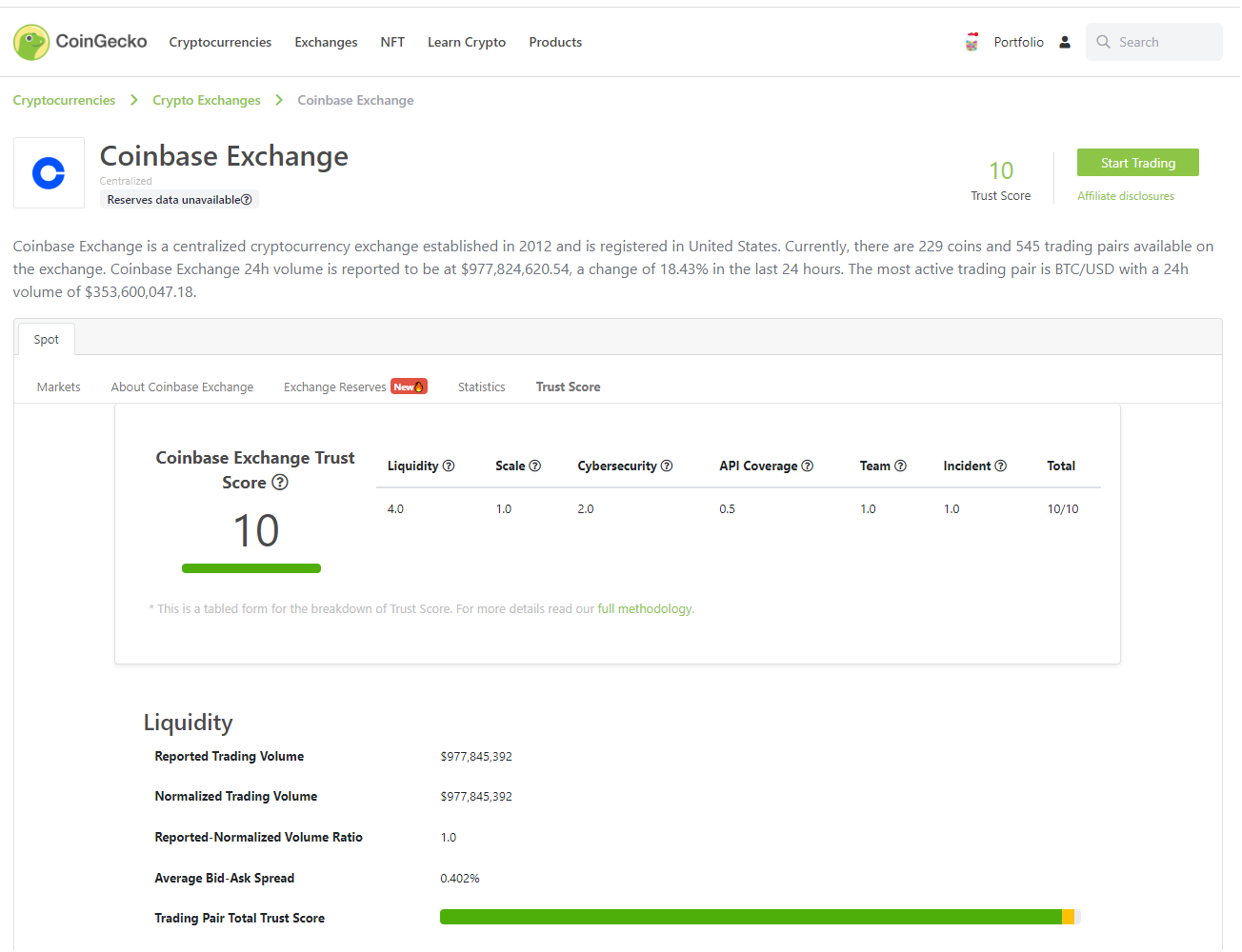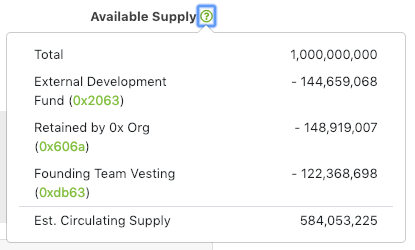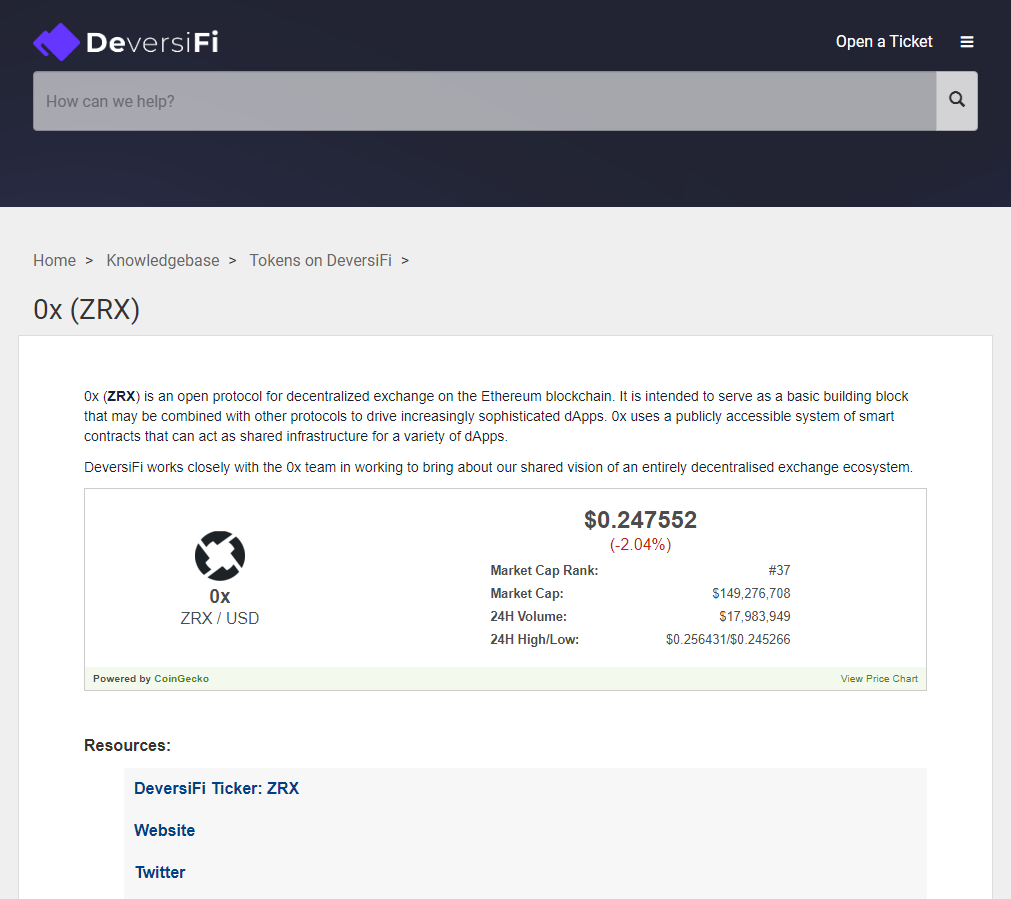Metodika
„CoinGecko“ pateikia daugybę įvairių duomenų apie daugybę skirtingų kriptovaliutų. Visi duomenys, kuriuos gauname arba kurių užklausiame iš įvairių šaltinių, yra apdorojami įvairiais „CoinGecko“ algoritmais, kurie patikrina duomenų vientisumą. Skaitykite toliau, kad sužinotumėte, kaip apskaičiuojame ir vertiname įvairius „CoinGecko“ turimus rodiklius.Pasitikėjimo balas
1. Prekybos poros
Kiekvienai „CoinGecko“ prekybos porai patikimumo balas apskaičiuojamas atsižvelgiant į:- prekybos keitykloje statistiką (pagal „SimilarWeb“);
- prekybos maržą ir ±2 % gylį;
- bendrą prekybos apimtį
- prekybos dažnumą;
- atvirkštinius patikrinimus.
Patikimumo balas rodomas žalios / geltonos / raudonos arba jokios spalvos, skiltyje „Patikimumo balas“. Toliau padarytų ekrano nuotraukų rinkinys iliustruoja skirtumą tarp skirtingų patikimumo balo spalvų. Taip pat galite pereiti tiesiai į monetų puslapius (pvz., Bitcoin, Litecoin) ir pamatyti, kaip tai veikia!




2. Kriptovaliutų keityklos (neatidėliotinų sandorių)
Neatidėliotinų sandorių kriptovaliutų keityklų patikimumo balas rodomas 1–10 balų skalėje keityklos apžvalga puslapyje.
- bendrasis likvidumas;
- produkcijos mastas;
- API aprėptis;
- kibernetinis saugumas;
- komandos buvimas;
- praeities incidentai;
- turto įrodymas;
- įsipareigojimų įrodymas (numat. 2023 m. I pusmetis)

Išsamią metodiką galima rasti „CoinGecko“ tinklaraštyje suvestiniu formatu čia arba atskiruose leidiniuose:
- Patikimumo balas 1 (2019 m. gegužė) – reitinguoja prekybos poras pagal interneto srautą, likvidumą ir su prekybos veikla susijusius rodiklius.
- Patikimumo balas 2 (2019 m. rugsėjis) – reitinguoja keityklas pagal interneto srautą, likvidumą, mastą ir API aprėptį.
- Kibernetinio saugumo patikimumo balo atnaujinimas (2012 m. liepa) – patobulinamas 2 patikimumo balas, įtraukiant kibernetinio saugumo vertinimą.
- Komandos buvimo ir incidentų valdymo patikimumo balo atnaujinimas (2020 m. lapkritis) – įtraukiamas operatyvinių veiksnių, tokių kaip komandos buvimas ir ankstesni incidentai, vertinimas.
- Patikimumo balas 3. Rezervų įrodymas (2023 m. sausis) – į patikimumo balą įtraukiami rezervų duomenys, kurie bus naudojami kaip algoritmo dalis reitingavimo tikslais.
3. Kriptovaliutų keityklos (išvestinių finansinių priemonių)
Šiuo metu patikimumo balas nėra prieinamas Išvestinių finansinių priemonių prekybos poros arba Derivatyvų keityklos. Išvestinių finansinių priemonių prekybos poros ir išvestinių finansinių priemonių keityklos reitinguojamos pagal jų atitinkamus Atvirų palūkanų ir Prekybos apimties duomenis, apie kuriuos pranešama.Rinkos duomenys
1. Kaina (kriptoturtas)
Kriptorutro kaina apskaičiuojama remiantis turimomis ir „CoinGecko“ iš įvairių keityklų surinktomis konkretaus kriptoturto prekybos poromis. „CoinGecko“ rodoma konkretaus kriptoturto rinkinio kaina apskaičiuojama pagal pasaulinę apimties ir svertinio kainos vidurkio formulę.a. Calculating the Bitcoin Price Index (BPI)
All ticker data on CoinGecko are stored in BTC base. To convert all ticker data to BTC, we utilize the BPI as the internal reference Bitcoin conversion rate to all fiat currencies.1 pavyzdys (skirtingos FIAT poros)
Kaip pavyzdį pasitelkdami bitkoiną (BTC) ir darydami prielaidą, kad stebime tik dvi keityklas A ir B, kuriose prekiaujama JAV doleriais ir Japonijos jenomis:Keitykla A: BTC/USD = 1 000 USD / BTC @ 15 000 BTC prekybos apimtis (slenkanti 24 val.)
Keitykla B: BTC/JPY = 109 000 JPY / BTC @ 10 000 BTC prekybos apimtis (slenkanti 24 val.)
„CoinGecko“ pirmiausia konvertuos JPY į USD, naudodama valiutų kursus, kuriuos pateikia %{link}. Darant prielaidą, kad 1 USD = 110 JPY, tai reikš:
Keitykla B: BTC/JPY = 109 000 JPY / BTC ≈ 990 USD / BTC
Tada „CoinGecko“ apskaičiuos pasaulinę svertinę vidutinę kainą pagal apimtį. Šiuo atveju ji bus tokia:
„CoinGecko“ BTC kaina (USD)
= [apimties % * USD kaina] + [apimties % * konvertuota USD kaina]
= [ 15 000 / (15 000 + 10 000) ] * 1 000 USD + [ 10 000 / (15 000 + 10 000) ] * 990 USD
= 0,6 * 1 000 USD + 0,4 * 990 USD
= 996 USD
2 pavyzdys (FIAT ir kitų kriptovaliutų poros)
Kaip pavyzdį pasitelkdami „Ethereum“ (ETH) ir darydami prielaidą, kad stebime tik dvi keityklas A ir B, kuriose prekiaujama USD ir BTC:Keitykla A: ETH/USD = 200 USD / ETH @ 30 000 ETH prekybos apimtis (slenkanti 24 val.)
Keitykla B: ETH/BTC = ₿ 0. 20000000 / ETH @ 20 000 ETH prekybos apimtis (slenkanti 24 val.)
„CoinGecko“ pirmiausia konvertuos ETH/BTC kainą į USD kainą, naudodama pirmiau išvestą „CoinGecko“ BTC kainą. Darant prielaidą, kad 1 BTC = 996 USD, tai reikš:
Keitykla B: ETH/BTC = ₿ 0,20000000 / ETH ≈ 199,2 USD / ETH
Tada „CoinGecko“ apskaičiuos pasaulinę vidutinę svertinę kainą. Šiuo atveju ji bus tokia:
„CoinGecko“ ETH kaina (USD)
= [ 30 000 / (30 000 + 20 000) ] * 200 USD + [ 20 000 / (30 000 + 20 000) ] * 199,2 USD
= 0,6 * 200 USD + 0,4 * 199,2 USD
= 199,68 USD
Iš 1 ir 2 pavyzdžių gautos kainos JAV doleriais konvertuojamos į kitas vietines valiutas, pavyzdžiui, GBP, CNY, JPY, EUR ir t. t., naudojant %{link}, ir tada rodomos „CoinGecko“.
Pastaba: apskaičiuojant „CoinGecko“ pasaulinį apimties svertinį kainų vidurkį, neįtraukiami duomenų taškai, aptikti kaip nukrypimai, kaip paaiškinta 3 dalyje toliau.
b. Aggregating the market price for all coins
i) Initial Ticker Set Construction
In addition to displaying data from individual tickers, CoinGecko also displays one aggregated market price for coins. For the purpose of price aggregation, an initial ticker set is constructed based on the top 600 tickers by volume of a particular coin. We then filter out tickers if it is detected to be anomalous or do not meet selected criteria.ii) Price Outlier Detection and Exclusion
One of the most important anomalous ticker filters we utilize is price outlier detection, where tickers that display an outlier price within the ticker set are automatically excluded. There are currently two different outlier detection algorithms depending on the number of available tickers in the ticker set. For coins with less than three tickers, any ticker price change that is greater than 100x from the previous price will be classified as an outlier. For coins with three tickers or more, CoinGecko applies an outlier detection algorithm by calculating the lower and upper bounds based on the median absolute deviation (MAD). If the price falls outside the bounds, we consider those tickers as outliers.iii) Final Price Aggregation
Once outliers have been removed, we calculate the VWAP of all remaining tickers in the ticker set to arrive at the final aggregated price. In certain cases, our operations team may intervene to exclude outliers if the team believes a certain ticker price to be anomalous but was not excluded by our outlier detection algorithm.4. Prekybos apimtis (keitykla)
Keityklos prekybos apimtis yra visų konkrečioje keitykloje esančių prekybos porų prekybos apimčių suma. Pavyzdžiui, tarkime, keitykla A turi 2 skirtingas monetas (ETH ir LTC) ir abi turi USD ir BTC poras:Imant ETH = 200 USD ir LTC = 100 USD iš „CoinGecko“ pasaulinės vidutinės svertinės apimties kainos ir esant tokiai kiekvienos poros prekybos apimčiai (slenkančios 24 val.):
ETH/BTC = 400 ETH
ETH/USD = 100 ETH
LTC/BTC = 3 000 LTC
LTC/USD = 2 000 LTC
Tada keityklos A prekybos apimtis yra:
400 ETH + 100 ETH + 3 000 LTC + 2 000 LTC = 600 000 USD
Atkreipkite dėmesį, kad „CoinGecko“ keityklos prekybos apimties skaičiavimo algoritmas neįtraukia prekybos porų, kurios buvo įtrauktos į juodąjį sąrašą dėl nenuoseklių duomenų ir nebuvo atnaujintos daugiau nei 3 valandas. Taip siekiama užtikrinti, kad apibendrinta apimtis kuo tiksliau atspindėtų rinkos sąlygas.
5. Prekybos apimtis (pasaulinė)
Pasaulinė 24 valandų prekybos apimtis (svetainės viršuje, po meniu juosta) – tai visų keityklų prekybos apimčių, kurias stebi „CoinGecko“, suma.
6. Apyvartinė pasiūla
Informacija apie „CoinGecko“ rodomą apyvartinę pasiūlą gaunama iš įvairių žetonų komandų ir yra tikrinama „CoinGecko“ komandos. Jei „CoinGecko“ negali patikrinti tokios informacijos tikslumo, apyvartinė pasiūla bus pažymėta simboliu „-“.Informacija apie apyvartinę pasiūlą rodoma „CoinGecko“, o šio skaičiavimo šaltinis nurodomas spustelėjus simbolį šalia teksto apie apyvartinę pasiūlą. Informacija apie apyvartinę pasiūlą naudojama kriptovaliutų rinkos kapitalizacijai apskaičiuoti.
Kalbant apie „Proof-of-Work“ monetas, „CoinGecko“ naudoja API galinį tašką iš monetos blokų tyrėjo, kad užklaustų apie turimų monetų kiekį. „CoinGecko“ į apyvartinės pasiūlos apskaičiavimą įtraukia neiškastas monetas, nes šias monetas gali parduoti bet kas, kas turi šių monetų kontrolę.

Žetonų, išleistų išmaniųjų sutarčių platformose (pvz., ERC-20 žetonų Ethereum), apyvartinę pasiūlą apskaičiuojame iš bendros pasiūlos atimdami užrakintus žetonus. Užrakinti žetonai gali apimti fondo fondą, investuotojų užrakintus žetonus, komandos užrakintus žetonus ir pan. Šių užrakintų žetonų adresai gaunami iš žetonų komandų.

Užrakintų adresų žetonų likutis gaunamas automatiškai iš blokų tyrėjo, kai tik pasiekiama API. 0x atveju, kadangi tai yra ERC-20 žetonas, 0x adresų žetonų likučiai automatiškai gaunami iš „Etherscan“ ir atimami iš bendros 0x pasiūlos.
7. Rinkos kapitalizacija (kriptoturtas)
Kriptoturto rinkos kapitalizacija apskaičiuojama pagal šią formulę:Čia:
A = dabartinė kriptoturto kaina JAV doleriais
B = turto apyvartinė pasiūla
Rinkos kapitalizacija = A * B
Pavyzdžiui, 0x rinkos kapitalizacija apskaičiuojama padauginus ZRX apyvartoje esančią pasiūlą iš jo kainos. Darant prielaidą, kad ZRX apyvartinė pasiūla yra 583 209 787, o ZRX kaina – 0,25 JAV dolerio, rinkos kapitalizacija apskaičiuojama taip: 583 209 787 * 0,25 JAV dolerio = 145 802 446,75 JAV dolerio.
8. Rinkos kapitalizacija (pasaulinė)
Pasaulinė rinkos kapitalizacija (svetainės viršuje, po meniu juosta) yra visų „CoinGecko“ stebimų projektų rinkos kapitalizacijos suma.
9. Visų laikų rekordas (ATH)
ATH „CoinGecko“ apskaičiuoja naudodama toliau nurodytus duomenis:i) ATH kaina
ii) ATH data
iii) dabartinė kaina
div) dabartinė data
% kritimas nuo ATH= (ATH kaina – dabartinė kaina) / (ATH kaina) * 100%
Data nuo ATH = dabartinė data – ATH data
Projektų sąrašai
Jūsų žetono ar keityklos įtraukimas į „CoinGecko“ sąrašą yra nemokamas ir joks „CoinGecko“ atstovas niekada neprašys iš jūsų jokio mokesčio už įtraukimą į sąrašą.Nors mielai priimtume bet kokias aukas (adresus rasite „CoinGecko“ svetainės poraštėje), atkreipkite dėmesį, kad tai negarantuoja įtraukimo į sąrašą ir nepagreitina jokios proceso dalies. Toliau išvardyti kai kurie kriterijai, kuriuos reikia atitikti, kad būtų svarstomas įtraukimas į „CoinGecko“ sąrašą. Tačiau atkreipkite dėmesį, kad šių kriterijų atitikimas automatiškai negarantuoja įtraukimo į sąrašą, nes „CoinGecko“ taip pat vertina daugelį kitų veiksnių prieš įtraukdama bet kokį projektą į mūsų svetainės sąrašą.
„CoinGecko“ pasilieka teisę be išankstinio įspėjimo paskelbti arba atšaukti bet kurį mūsų svetainėje į sąrašą įtrauktą kriptoturtą, ICO ar keityklą, jei manome, kad kuri nors pateikta informacija yra netiksli. „CoinGecko“ nepateiks atnaujinimų, jei kriptoturtas / ICO / keitykla neįvykdys kurios nors peržiūros proceso dalies.
Įtraukimo į sąrašą kriterijai:
(1) Kriptoturtas- Dirbanti, veikianti interneto svetainė, kurioje yra pakankamai informacijos apie į sąrašą įtraukiamą kriptoturtą. Svetainės, kuriose nėra informacijos apie paskirtį, komandą ar socialinių tinklų profilius, bus laikomos negaliojančiomis.
- Svetainė turi priklausyti projektui / ją prižiūrinčiai komandai. Svetainės, patalpintos svetainių kūrėjų (pvz., „Wix“) svetainėse, nebus priimamos.
- Veikianti blokų naršyklė
- Įtraukta į bent vienos (1) aktyvios keityklos, su kuriomis integruota „CoinGecko“, sąrašą.
- Projektai, kuriais prekiaujama tik savitarnos centralizuotose / decentralizuotose keityklose, gali būti atmesti dėl saugumo sumetimų.
- Rinkos kapitalizacijai apskaičiuoti turi būti aiškiai nurodyta apyvartinė pasiūla (pvz. bet kokia įmonė / fondas / komanda / kūrėjai / investavimas / užrakinti žetonai).
- Dirbanti keityklos interneto svetainė su faktinėmis prekybos apimtimis, atitinkančiomis API pateiktą informaciją.
- Patenkina „CoinGecko“ kriptovaliutų biržos API standartai.
- Dirbanti REST API dokumentacija.
- Turėti atstovą, su kuriuo komanda galėtų lengvai bendrauti dėl bet kokių klausimų.
- Informacijos apie monetą puslapis, kuriame būtų nurodyta kiekviena keitykloje prekiaujama moneta Reikalaujama pagrindinė informacija: pavadinimas, žymuo, logotipas, monetos interneto svetainė, blokų naršyklė Priimtino informacijos apie monetą puslapio pavyzdys: „DeversiFi“ žetonų informacija.

Darytina ir nedarytina pateikiant paraišką įtraukti į sąrašą:
Yra tam tikrų dalykų, kuriais galite mums padėti, kad sąrašo pateikimo procesas vyktų kuo sklandžiau.Darykite:
- Pateikite kuo daugiau tikslios informacijos „CoinGecko“ užklausos forma.
- Užtikrinkite, kad nebūtų neveikiančių / blogų nuorodų.
- Pateikite bilietą adresu support.coingecko.com, jei turite papildomų klausimų.
- Neteikite daugkartinių užklausų.
- Pakartotinai neprašykite atnaujinti būseną.
- Nesiūlykite niekam finansinės naudos už įtraukimą į sąrašą.
- Nepriimkite jokių pasiūlymų iš kitų asmenų, kurie teigia, kad gali pagreitinti ar garantuoti jūsų įtraukimą į sąrašą.
Atminkite, kad „CoinGecko“ atstovai niekada neprašys jūsų jokių mokesčių už įtraukimą į sąrašą.
Įtraukimo į sąrašą proceso eiga:
Kriptoturtas- Užpildykite „CoinGecko“ užklausos forma. (žr. vadovą čia)
- „CoinGecko“ peržiūri užklausas.
- Jeigu peržiūros rezultatas teigiamas, „CoinGecko“ įtraukia kriptoturtą į sąrašą.
- Pateikėjai gali patikrinti įtraukimo į sąrašą būseną čia.
- Pateikite „CoinGecko“ užklausos forma.
- „CoinGecko“ peržiūri prašymus.
- Jei keitykla atitinka visus kriterijus, „CoinGecko“ atstovas susisieks su jumis el. paštu ir sudarys keityklos įtraukimo į sąrašą sutartį (taikoma įtraukiant į CEX sąrašą).
- „CoinGecko“ programuotojas dirbs prie keityklos integracijos.
- „CoinGecko“ komanda dar kartą patikrins kodą ir, jei jis praeis visas patikras, keityklos API bus sujungta su „CoinGecko“ vidine keityklos biblioteka. Keityklos privalo laikytis „CoinGecko“ kriptovaliutų biržos API standartai, kad būtų lengviau įtraukti keityklą į sąrašą.
- „CoinGecko“ komanda patikrins kiekvieną prekybos porą ir suderins ją su esama kriptovaliuta, įtraukta į „CoinGecko“ sąrašą.
- Keityklos informacija bus užpildyta (paveikslėliai, aprašymas, mokesčiai ir t. t.).
- Keityklos integracija baigta ir keitykla įtraukta į „CoinGecko“ sąrašą.



 Arba peržiūrėkite ją programėlių parduotuvėse
Arba peržiūrėkite ją programėlių parduotuvėse